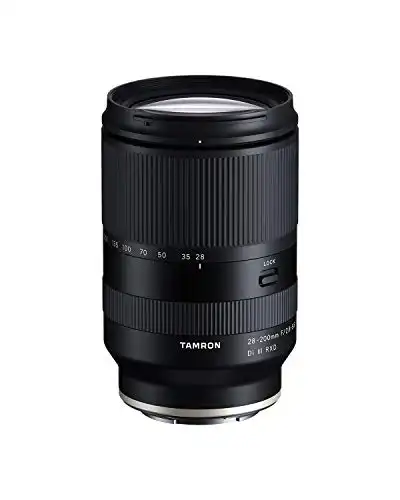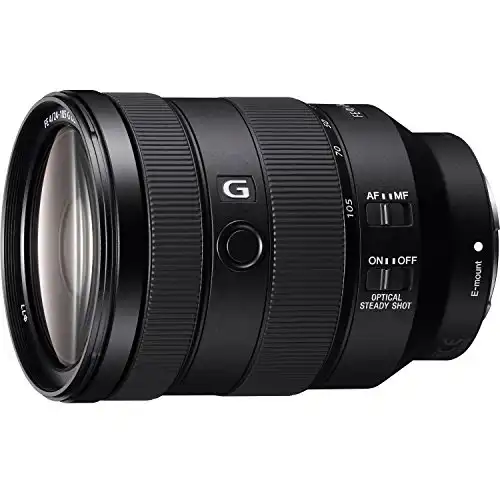The Tamron 28-200mm f/2.8-5.6 Di III RXD and the Sony FE 24-105mm f/4 G OSS are two zoom lenses for Sony E-mount mirrorless cameras with full-frame coverage.
In this comparison, we will look at the main features, and pros and cons of the Tamron 28-200mm f/2.8-5.6 Di III RXD vs Sony FE 24-105mm f/4 G OSS, based on various sources¹²³⁴. So keep on reading!
These two lenses both offer a versatile focal length range that covers wide-angle to medium telephoto perspectives, suitable for a variety of scenes and subjects.
However, they have different aperture ratings, optical designs, autofocus systems and features that may affect their performance and suitability for different needs and preferences.

Introduction
The Tamron 28-200mm f/2.8-5.6 Di III RXD was announced in June 2020 as a compact, lightweight and travel-friendly zoom lens for Sony E-mount cameras. It is part of Tamron's Di III series of lenses, which are designed specifically for mirrorless cameras with full-frame sensors.
It has a mixture of versatility and speed that makes it an ideal choice for photographing beautiful vistas, distinctive architecture, notable street scenes and more. It has a relatively fast maximum aperture that provides consistent exposure and depth of field control throughout the zoom range.
The Sony FE 24-105mm f/4 G OSS was announced in October 2017 as a standard zoom lens for Sony E-mount cameras with full-frame or APS-C sensors. It is part of Sony's G series of lenses, which are designed to deliver high image quality and performance.
This lens has a constant maximum aperture of f/4 throughout the zoom range, which provides good low-light performance and bokeh quality. It also has optical image stabilization (OSS) to reduce camera shake and blur.
Features: Tamron 28-200mm f/2.8-5.6 Di III RXD vs Sony FE 24-105mm f/4 G OSS
| Feature | Tamron 28-200mm | Sony FE 24-105mm |
| Mount | Sony E (FE) | Sony E (FE) |
| Full Frame | Yes | Yes |
| Autofocus | Yes | Yes |
| Image Stabilization | No | Yes (OSS) |
| Lens Construction | 18 elements in 14 groups | 17 elements in 14 groups |
| Special Elements | Hybrid aspherical element, LD (Low Dispersion) element, XLD (eXtra Low Dispersion) element, GM (Glass Molded Aspherical) element, BBAR (Broad-Band Anti-Reflection) coating | Four aspherical elements, three ED (Extra-low Dispersion) elements, Nano AR coating |
| Angle of View | 75.3-12.3 degrees | 84-23 degrees |
| Diaphragm Blades | 7 | 9 |
| Minimum Aperture | f/16-32 | f/22 |
| Minimum Focusing Distance | 0.19m (W) 0.8m (T) | 0.38m |
| Maximum Magnification Ratio | 0.32x (W) 0.26x (T) | 0.31x |
| Filter Size | 67mm | 77mm |
| Dimensions | 74 x 117mm | 83 x 113mm |
| Weight | 575g | 663g |
| Weather Sealing | Yes | Yes |
| Lens Hood Included | Yes | Yes |
Pros and Cons
Best For: Photographers seeking a versatile all-in-one lens solution with exceptional portability and high-resolution image rendering capabilities.
- Versatile all-in-one zoom lens suitable for various photography applications
- Lightweight and compact design for easy travel and convenience
- Excellent image quality, sharpness, and fast autofocus performance
- Limited maximum aperture range may not be ideal for low-light or night photography
Tamron 28-200mm
| Pros | Cons |
| Compact and lightweight | No optical image stabilization |
| Relatively fast aperture rating | Comparatively limited wide-angle potential |
| Impressive image quality for a zoom lens | Some autofocus issues reported by some users |
| Weather-sealed construction | Some distortion and vignetting at wide-angle settings |
| Close focusing distance | |
| Fast and quiet autofocus system | |
| Affordable price |
Best For: Photographers seeking a versatile, all-in-one solution with exceptional optical quality and professional performance.
- Compact and lightweight design
- Impressive optical quality with minimal aberrations
- Fast and precise autofocus
- Constant F4 maximum aperture may not suit low light situations
Sony FE 24-105mm
| Pros | Cons |
| Constant maximum aperture | Larger and heavier |
| Optical image stabilization | Higher price |
| Excellent image quality for a zoom lens | Some distortion and chromatic aberration at wide-angle settings |
| Weather-sealed construction | |
| Good focusing distance | |
| Fast and reliable autofocus system | |
| Smooth and circular bokeh |
Conclusion
The Tamron 28-200mm f/2.8-5.6 Di III RXD and the Sony FE 24-105mm f/4 G OSS are both useful zoom lenses for Sony E-mount photographers who need a versatile and flexible lens for various situations and subjects. They both offer good image quality and performance overall, but they also have some differences that may make one more suitable than the other for different needs and preferences.
The Tamron 28-200mm f/2.8-5.6 Di III RXD offers a faster maximum aperture that provides consistent exposure and depth of field control throughout the zoom range, as well as better low-light performance and bokeh quality.
It is also more compact, lightweight and weather-sealed than the Sony FE 24-105mm f/4 G OSS, making it more travel-friendly and durable. It also has a closer focusing distance and a higher magnification ratio, making it more capable of macro photography. It is also more affordable than the Sony FE 24-105mm f/4 G OSS.
The Sony FE 24-105mm f/4 G OSS offers a constant maximum aperture of f/4 throughout the zoom range, which provides good low-light performance and bokeh quality. It also has optical image stabilization that reduces camera shake and blur, especially at longer focal lengths and slower shutter speeds.
It also has an excellent image quality for a zoom lens, with high sharpness, contrast, color and minimal aberrations. It also has a fast and reliable autofocus system that works well with Sony's eye AF and tracking modes.
If you are looking for a zoom lens that offers a fast aperture, a compact and weather-sealed build, a close focusing distance and an affordable price, then the Tamron 28-200mm f/2.8-5.6 Di III RXD may be the better choice for you.
But if you are looking for a zoom lens that offers a constant aperture, optical image stabilization, excellent image quality and performance, and a smooth and circular bokeh, then the Sony FE 24-105mm f/4 G OSS may be the better choice for you.
However, neither of these lenses can match the image quality or performance of dedicated prime or zoom lenses with shorter focal length ranges, so you may want to consider other options if you are looking for the best possible results in terms of sharpness, contrast, distortion, aberration or bokeh.
Further Reading:
(1) Tamron 28-200mm f2.8-5.6 Di III RXD review – Digital Camera World
(2) Tamron 28-200mm vs Sony 24-105mm – Best Travel Coverage Lens?
(3) Question: Tamron 28-200 vs Sony 24-105/4 – Digital Photography Review


